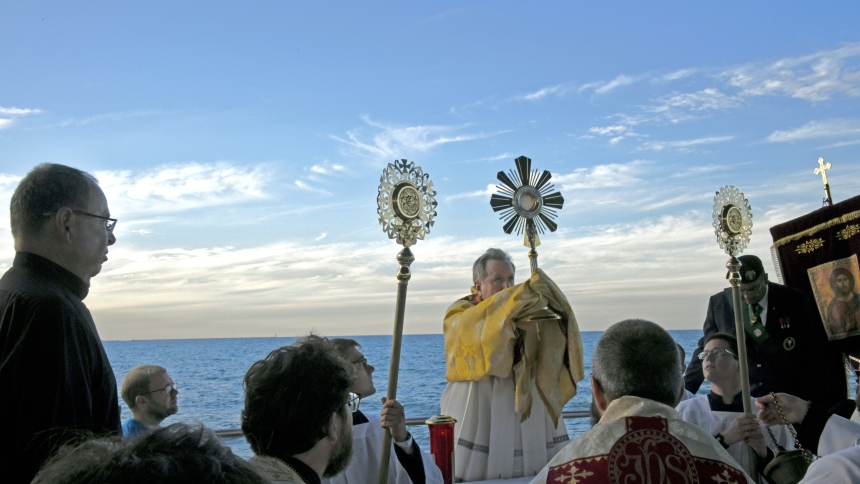
WHITING – In the “Little City by the Lake,” more than 500 people gathered for prayer, procession, benediction and festivities beckoned by the Real Presence of the Eucharistic Lord as the Marian Route of the National Eucharistic Pilgrimage arrived on July 1 in Northwest Indiana.
Among the faithful who gathered as perpetual pilgrims were transported from Illinois in a special van equipped to house a tabernacle for a consecrated host, was a sense of East meeting West.
Host parish St. Mary Byzantine Catholic Church in Whiting, which features ornate art including a large icon of Christ Pantocrator, represented a welcoming embrace from the “two lungs” of the Catholic Church – those Eastern Churches in union with the Roman Catholic Church.
“I’m happy to be Catholic,” Father Andrew Summerson, pastor of St. Mary. “The Catholic Church is part of Whiting’s DNA, so I think doing this today helps us live our vocation … and helps others live their vocations.”
Opening a time of prayer before the Blessed Sacrament, when confessions were made available to visitors, Father Summerson emphasized how the religious art is a metaphor for those gathering to walk with the Lord.
“Christ is overlooking us and you see he is cut off at the waist,” he said about the dome icon. “Where is the rest of His body? It’s on the floor – we’re the body of Christ,” said Father Summerson.
Eloise Marie Valadez, a local journalist for a secular publication, took time off work to join those gathered in prayer to kick off the Eucharistic Pilgrimage’s journey in the state whose capital, Indianapolis, will host the National Eucharistic Congress on July 17-21.
“This is a beautiful thing; it’s something that is unusual,” said Valadez, a Chicago resident. “(The Eucharistic Pilgrimage) is a historical event, and being a Catholic, I want to keep strengthening my faith.
She added, “What we’re witnessing here is that they are bringing Jesus across the country, and that is the ultimate sign of love.”
Mason Bailey, a Marian Route perpetual pilgrim and seminarian for the Diocese of Fort Wayne-South Bend, prepared to participate in the local procession. “It is great to be back here in Northern Indiana. I can’t wait to continue through Gary and to my diocese.”
Catholic author Mike Aquilina presented his talk “Like Lions Breathing Fire: The Early Christians and the Eucharist," before pilgrims queued up for a Eucharistic procession.
“Jesus said, ‘I am the Bread of Life,’ and ‘This is my body,’ and ‘My flesh is real food,’” Aquilina said. “These are simple declarative sentences that seem to bear the weight of impossibility. Yet nothing is impossible for God, and Jesus is God.”
Prophets of the Old Testament foreshadowed the sacrificial nature of Jesus’ ministry and the worship that would be offered to Him universally, explained Aquilina,“From the rising of the sun to its setting, from East to West, from dawn to dusk, He meant always and he meant everywhere. Isn’t that so beautifully visible today in this gathering?”
Father Mick Kopil, pastor of St. Elizabeth Ann Seton in Valparaiso, carried a consecrated host in the Eastern tradition – in a chalice covered by a veil. Two seminarians provided reverent protection from the elements by each holding aloft a gold ripidas, or seraphic fan.
After tracing a route through the dense grid of city streets with the setting sun to their backs, pilgrims crossed over train tracks and entered Whiting Lakefront Park. In a gazebo on the shores of Lake Michigan, Bishop of Gary Robert J. McClory presided over a benediction. Worshippers crowded into the structure which featured views of the Chicago skyline to the west and beaches and steel mills to the east.
Parishioners from Whiting Catholic churches including St. Mary, Sacred Heart, St. Adalbert and St. John the Baptist joined groups such as the local Knights of Columbus to provide hospitality to visitors, many of whom remained for festivities at the park.
From Highland, Stephen and Teresa Lekan brought their children Annabelle, 8, and James, 4, to the procession “to follow Jesus.”
“We heard about the pilgrimage and it was something we hadn’t done before … so we thought we should probably come out,” Lekan said.
Despite the secular tilt to today’s culture, Lekan said he hopes to show his children that “this is the norm,” and religious pilgrimages should be “a regular thing.”
Maricela Ramirez walked the length of the procession with her husband Fernando. The St. Casimir of Hammond parishioners took turns pushing a wheelchair in which her mother Margarita Miramontes sat and prayed her Rosary.
In Spanish, Miramontes said, “I feel very good. I’m very happy, I’m very blessed to be here with our Lord.”
Of Polish ancestry, now a U.S. citizen and Florida resident, Krzysztof Humienny said he diverted plans so he could be a part of the Marian Route of the pilgrimage.
“I was at a wedding in Western Wisconsin and I decided to go on this pilgrimage, which (I am happy) is happening in my country, the United States of America,” explained Humienny.
Father Declan McNicholas, director of missionary discipleship and evangelization for the Diocese of Gary was moved by the public witness of faith.
“When we walked up to the lake … and all the people from the east and west coming together as Catholics before the Blessed Sacrament was a powerful symbol of unity,” said Father McNicholas.
Caption: Bishop Robert J. McClory elevates the monstrance during benediction at Lakefront Park in Whiting as worshippers kneel before the Blessed Sacrament along with members of the perpetual pilgrims contingent traveling on the Marian Route of the National Eucharistic pilgrimage on July 1. Hundreds of diocesan faithful and visitors took part in the day's Christ-centered prayer, presentations, procession, benediction and festivities, which began at St. Mary Byzantine Catholic church and concluded at the Lake Michigan shore. (Anthony D. Alonzo photo)

